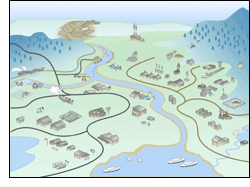Tribal Brownfields Funding Examples:
 The
"Tribal Brownfields and Response Programs: Respecting Our Land, Revitalizing Our Communities" report explores
how tribes are using U.S. Environmental Protection Agency (EPA) brownfields funding to address contaminated land in Indian
country and discusses the challenges they face. It provides an historic overview of EPA's Brownfields Program, as it
relates to tribes, and includes examples of tribal successes to both highlight accomplishments and serve as a resource
for ideas, information and reference.
The
"Tribal Brownfields and Response Programs: Respecting Our Land, Revitalizing Our Communities" report explores
how tribes are using U.S. Environmental Protection Agency (EPA) brownfields funding to address contaminated land in Indian
country and discusses the challenges they face. It provides an historic overview of EPA's Brownfields Program, as it
relates to tribes, and includes examples of tribal successes to both highlight accomplishments and serve as a resource
for ideas, information and reference.For updated versions of EPA’s State and Tribal Brownfields Publications go to:
EPA’s BF Publications
For current newsletters describing the progress that states and tribes are making to address contaminated land in their communities go to:
EPA’s BF State & Tribal Program Updates
Here are some additional examples of what Tribes have done with Brownfields, other sources of funding, and technical assistance:
- Form a Tribal Emergency Response Committee (TERC) to develop a Pre-Disaster Mitigation Plan, an asset inventory, and identify critical environmental threats to the Reservation and its people in preparation for a potential environmental release.
- Develop an inventory of properties and a public record, obtaining technical training for staff members, and conducting outreach and education to engage the community in environmental issues.
- Host environmental enforcement workshop for Tribal Response Program staff. Topics included developing tribal codes, civil compliance and enforcement processes, as well as the history of tribal environmental law.
- Provide environmental training by coordinating EPA resources.
- Complete a community background soil survey to guide future Tribal decisions on whether a cleanup or corrective action taken at a brownfield property for metals complies with the goal of removal of contaminants to achieve risk-based cleanup standards or reduce levels to background or lower.
- Increase tribal capacity by building expertise through finding funding, and overseeing cleanup.
- Assess property found to have soil and ground water contamination.
- Complete assessment, abatement, demolition, disposal, and environmental cleanup of abandoned and partially collapsed buildings that pose a threat to public health and the environment with hazards such as asbestos and lead-based paint.
- Inventory of sites for future cleanups.
- Identify, inventory, and clean up properties to address environmental concerns on tribal land.
- Collect environmental information, analyzing risk and ranking properties.
- Develop standard operating procedures (SOP) for illegal dump or burn area cleanups.
- Spur tourism through historical preservation and community enhancement.
- Make Brownfields information available to the public through direct outreach.
- Develop a solid waste ordinance that includes requirements for solid and hazardous waste management.
- Develop a civil compliance and enforcement program to address illegal activities such as littering and illegal dumping.
- Update environmental codes to prevent new Brownfields.
- Partner to inventory, assess and clean up former mining sites.
- Work with state and federal partners to heighten oil spill response capability.
- Establish community gardens, cultural education buildings, community centers, and parks.
Related Pages:
Alaska Tribal Response Program Training ModulesBrownfields
Tribal Response Program Training Modules
For more information, please contact:
Jennifer Williams, Alaska Program Coordinator, Sr.
Tel: 928/523-0673
Email: Jennifer.Williams@nau.edu
Tel: 928/523-0673
Email: Jennifer.Williams@nau.edu
Last updated: April 15, 2016
